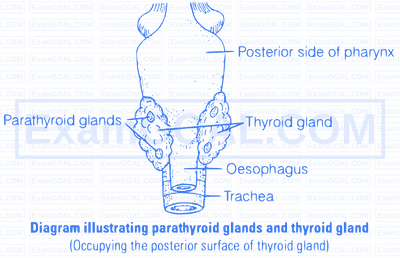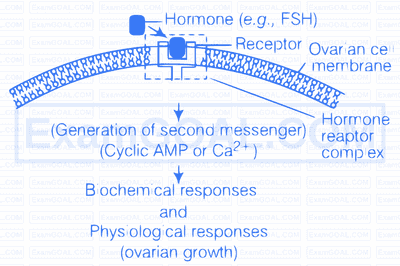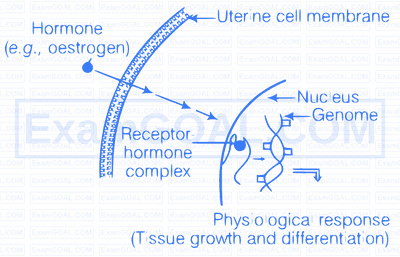The endocrine glands and hormones that are responsible for maintaining calcium homeostasis, are thyroid and parathyroid glands and their associated hormones are calcitonin and Parathyroid Hormone (PTH).
(i) Parathyroid glands are the glands developed from the endoderm of the embryo. The cells of parathyroid glands are of two types, i.e., chief cells and oxyphil cells. The chief cells of the parathyroid glands secrete parathyroid hormone (PTH).
This hormone (PTH) is involved in regulating calcium and phosphate balance between the blood and other tissue. It mobilises the release of calcium into the blood from bones. PTH increases calcium reabsorption by the body organs like intestine and kidneys.
(ii) Thyroid gland is the largest endocrine gland located anterior to the thyroid cartilage of the larynx in the neck. This gland plays a vital role in maintaining calcium homeostasis. It releases thyrocalcitonin hormone produced by the parafollicular cells, also called ' $C$ ' cells.
This hormone is secreted when the calcium level in blood gets high. It is a 32 amino acid peptide hormone that lowers the calcium level by suppressing release of calcium ions from the bones. Thus, calcitonin has an action opposite to that of the parathyroid hormone on calcium homeostasis.

Differences between the mechanism of action of a peptide and a steroid hormone are as follows
| Peptide Hormone Action | Steroid Hormone Action |
|---|---|
| Peptide hormones interact with membrane bound receptors. |
They interact with intracellular receptors to form hormone receptor complex |
| They generate second messengers (e.g. cyclic AMP, $\mathrm{IP}_3, \mathrm{Ca}^{2+}$, etc.) |
They regulate gene expression or chromosomes function by the interaction of hormone receptor complex with the genome. |
| The second messengers regulate cellular metabolism. e.g. oxytocin insulin, glucagon, vasopressin. etc, |
Cumulative biochemical actions results in physiological and development effects. e.g., cortisol, testosterone, estrogen and progesterone. |
 |
 |
Hypothalamus is a very small but extremely important part of the diencephalon that is involved in the mediation of endocrine, autonomic and behavioural function.
It contains several groups of neurosecretory cells called nuclei which produce hormones. Hypothalamus provides anatomical connection between the nervous and endocrine system. It controls the release of major hormones by the hypophysis which are summarised below
(i) Adrenocorticotrophic Releasing Hormone (ARH) It stimulates the anterior lobe of pituitary gland to secrete Adrenocorticotropic Hormone (ACTH). ACTH stimulates the synthesis and secretion of steroid hormones called glucocorticoids by adrenal glands.
(ii) Thyrotropin Releasing Hormone (TRH) It stimulates the anterior lobe of pituitary gland to release Thyroid Stimulating Hormone (TSH).
(iii) Growth Hormone Releasing Hormone It stimulates the anterior lobe of the pituitary gland to release growth hormone or somatostatin.
(iv) Gonadotropin Releasing Hormone It stimulates the anterior lobe of the pituitary gland to release gonadotropic hormones (FSH and LH).
(v) Prolactin Releasing Hormone (PRH) It stimulates the anterior lobe of the pituitary gland to secrete prolactin.
(vi) MSH Releasing Hormone It stimulates the intermediate lobe of the pituitary gland to secrete Melanocyte Stimulating Hormone (MSH)
These hormones released from hypothalamus are involved in the process like temperature regulation, control of water balance in body, sexual behaviour and reproduction, control of daily cycles in physiological state, behaviour and mediation of emotional responses. Hence, hypothalamus is called as super master endocrine gland of body.